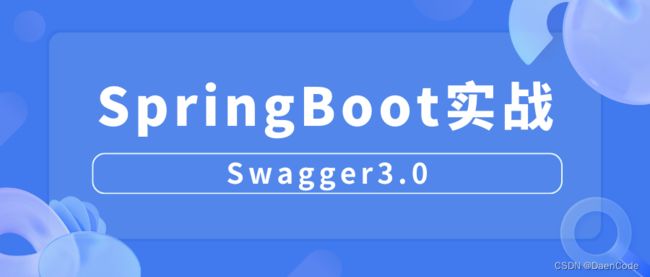SpringBoot2.7.14整合Swagger3.0的详细步骤及容易踩坑的地方
作者名称:DaenCode
作者简介:啥技术都喜欢捣鼓捣鼓,喜欢分享技术、经验、生活。
人生感悟:尝尽人生百味,方知世间冷暖。
所属专栏:SpringBoot实战
系列文章目录
以下是专栏部分内容,更多内容请前往专栏查看!
| 标题 |
|---|
| 一文带你学会使用SpringBoot+Avue实现短信通知功能(含重要文件代码) |
| 一张思维导图带你学会Springboot创建全局异常、自定义异常 |
| 一张思维导图带你打通SpringBoot自定义拦截器的思路 |
| 28个SpringBoot项目中常用注解,日常开发、求职面试不再懵圈 |
| 一张思维导图带你学会SpringBoot、Vue前后端分离项目线上部署 |
| 一张流程图带你学会SpringBoot结合JWT实现登录功能 |
| 一张思维导图带你学会使用SpringBoot中的Schedule定时发送邮件 |
| 一张思维导图带你学会使用SpringBoot异步任务实现下单校验库存 |
| 一张思维导图带你学会SpringBoot使用AOP实现日志管理功能 |
专栏推荐
- 专门为Redis入门打造的专栏,包含Redis基础知识、基础命令、五大数据类型实战场景、key删除策略、内存淘汰机制、持久化机制、哨兵模式、主从复制、分布式锁等等内容。
链接>>>>>>>>>《Redis从头学》 - 专门为RabbitMQ入门打造的专栏,持续更新中。。。。。。。。
链接>>>>>>>《图解RabbitMQ》
文章目录
- 系列文章目录
- 专栏推荐
- 引入依赖
- applicationproperties配置文件
- 配置类创建
- 常用注解
- 具体用法
-
- @ApiModel+@ApiModelProperty
- @Api+@ApiOperation+@ApiParam
- @ApiResponses+@ApiResponse
- 效果查看
- 写在最后
引入依赖
<dependency>
<groupId>io.springfoxgroupId>
<artifactId>springfox-boot-starterartifactId>
dependency>
applicationproperties配置文件
Springfox MVC路径匹配是基于AntPathMatcher的,而Spring Boot 2.7.14基于PathPatternMatcher。可以查看WebMvcProperties类。
 因此,修改mvc的匹配策略为ant_path_matcher。如果swagger与springboot匹配策略不一致则会有错误:
因此,修改mvc的匹配策略为ant_path_matcher。如果swagger与springboot匹配策略不一致则会有错误:
Failed to start bean ‘ documentationPluginsBootstrapper ‘ ; nested exception…
spring.mvc.pathmatch.matching-strategy=ant_path_matcher
配置类创建
@Component
@Data
@EnableOpenApi
public class SwaggerConfiguration {
/**
* 用户端接口文档
* @return
*/
@Bean
public Docket webApiDoc(){
return new Docket(DocumentationType.OAS_30)
.groupName("用户端接口文档")
.pathMapping("/")
//定义是否开启swagger
.enable(true)
.apiInfo(apiInfo())
.select()
.apis(RequestHandlerSelectors.basePackage("top.daencode"))
//正则匹配请求路径,并分配至当前分组
.paths(PathSelectors.ant("/api/**"))
.build()
//新版swagger3.0配置
.globalRequestParameters(getGlobalRequestParameters())
.globalResponses(HttpMethod.GET, getGlobalResponseMessage())
.globalResponses(HttpMethod.POST, getGlobalResponseMessage());
}
/**
* 管理端接口文档
* @return
*/
@Bean
public Docket adminApiDoc(){
return new Docket(DocumentationType.OAS_30)
.groupName("管理端接口文档")
.pathMapping("/")
//定义是否开启swagger
.enable(true)
.apiInfo(apiInfo())
.select()
.apis(RequestHandlerSelectors.basePackage("top.daencode"))
//正则匹配请求路径,并分配至当前分组
.paths(PathSelectors.ant("/api/**"))
.build()
.globalRequestParameters();
}
/**
* 接口文档元数据信息
* @return
*/
private ApiInfo apiInfo(){
return new ApiInfoBuilder()
.title("xxx项目接口文档")
.description("接口文档")
.contact(new Contact("daencode","https:daencode.top","[email protected]"))
.version("v1.0")
.build();
}
/**
* 生成全局通用请求参数
* @return
*/
private List<RequestParameter> getGlobalRequestParameters() {
List<RequestParameter> parameters = new ArrayList<>();
parameters.add(new RequestParameterBuilder()
.name("token")
.description("登录令牌")
.in(ParameterType.HEADER)
.query(q -> q.model(m -> m.scalarModel(ScalarType.STRING)))
.required(false)
.build());
// 可以配置多个
// parameters.add(new RequestParameterBuilder()
// .name("version")
// .description("版本号")
// .required(true)
// .in(ParameterType.HEADER)
// .query(q -> q.model(m -> m.scalarModel(ScalarType.STRING)))
// .required(false)
// .build());
return parameters;
}
/**
* 生成通用的接口文档响应信息
* @return
*/
private List<Response> getGlobalResponseMessage() {
List<Response> responseList = new ArrayList<>();
responseList.add(new ResponseBuilder().code("4xx").description("请求错误,根据code和msg检查").build());
return responseList;
}
}
注意:
- 使用@EnableOpenApi开启swagger3.0。
- apis(RequestHandlerSelectors.basePackage(“top.daencode”)):注意修改此处生效的包名。
- .paths(PathSelectors.ant(“/api/**”)):修改接口的通用路径。
- parameters.add:生成全局通用配置参数,比如说用户登录的token。
常用注解
| 注解 | 描述 |
|---|---|
| @Api | 用于描述整个API接口的信息,包括API的标题、描述等。 |
| @ApiOperation | 用于描述单个接口的操作信息,包括接口的HTTP方法、路径、描述等。 |
| @ApiParam | 用于描述接口参数的信息,包括参数名、类型、描述等。 |
| @ApiModel | 用于描述接口返回结果或请求体的模型信息。 |
| @ApiModelProperty | 用于描述模型属性的信息,包括属性名、类型、描述等。 |
| @ApiIgnore | 用于忽略某个API接口,使其不在生成的文档中显示。 |
| @ApiResponse | 用于描述接口的响应信息,包括响应码、描述、返回类型等。 |
| @ApiResponses | 用于描述多个接口响应的信息,可以与@ApiResponse配合使用。 |
具体用法
@ApiModel+@ApiModelProperty
@ApiModel("用户登录对象")
@Data
public class UserLogin {
@ApiModelProperty(value = "用户名",example = "daencode")
private String username;
@ApiModelProperty(value = "密码",example = "123456")
private String password;
@ApiModelProperty(value = "验证码",example = "3425")
private String captcha;
}
@Api+@ApiOperation+@ApiParam
@Api("用户模块")
@RestController
@RequestMapping("/api/v1/user")
public class UserController {
@Autowired
private UserService userService;
@PostMapping("login")
@ApiOperation("用户登录")
public JsonData login(@ApiParam("登录对象") @RequestBody UserLogin userLogin){
//token为空则返回失败,否则返回成功
String token=userService.login(userLogin);
return token==null?JsonData.buildError("登录失败"):JsonData.buildSuccess(token);
}
}
@ApiResponses+@ApiResponse
@ApiOperation("创建用户")
@ApiResponses(value = {
@ApiResponse(code = 201, message = "用户创建成功", response = User.class),
@ApiResponse(code = 400, message = "请求参数有误"),
@ApiResponse(code = 401, message = "未授权访问"),
@ApiResponse(code = 500, message = "服务器内部错误")
})
@PostMapping("/users")
public ResponseEntity<User> createUser(@RequestBody User user) {
// ...
}
效果查看
1.前往postman发起接口请求测试。

2.访问:http://localhost:8080/swagger-ui/index.html,查看接口文档。

写在最后
有关于SpringBoot2.7.14整合Swagger3.0的详细步骤及容易踩坑的地方到此就结束了。感谢大家的阅读,希望大家在评论区对此部分内容散发讨论,便于学到更多的知识。
![]()
